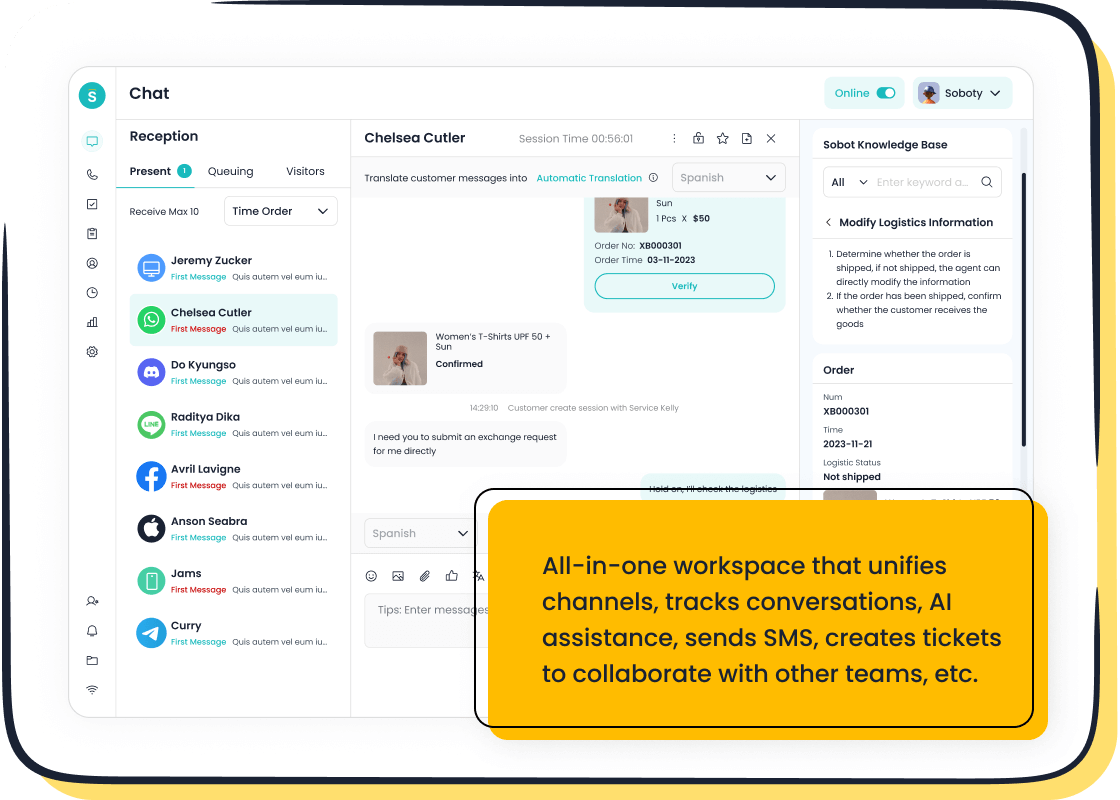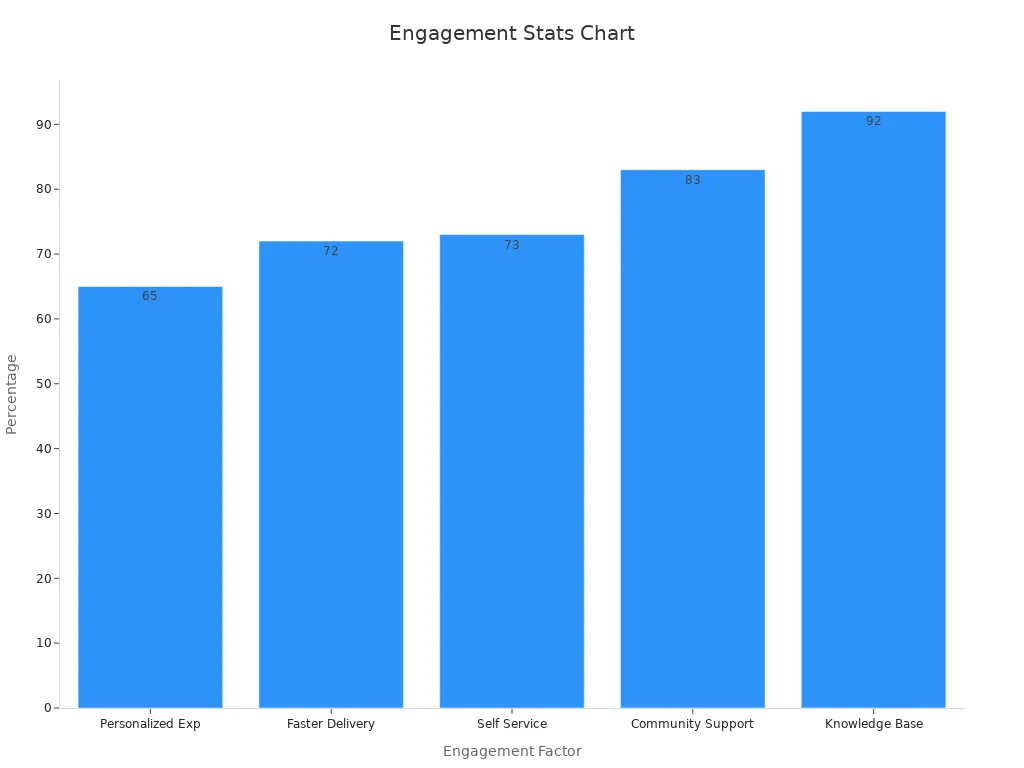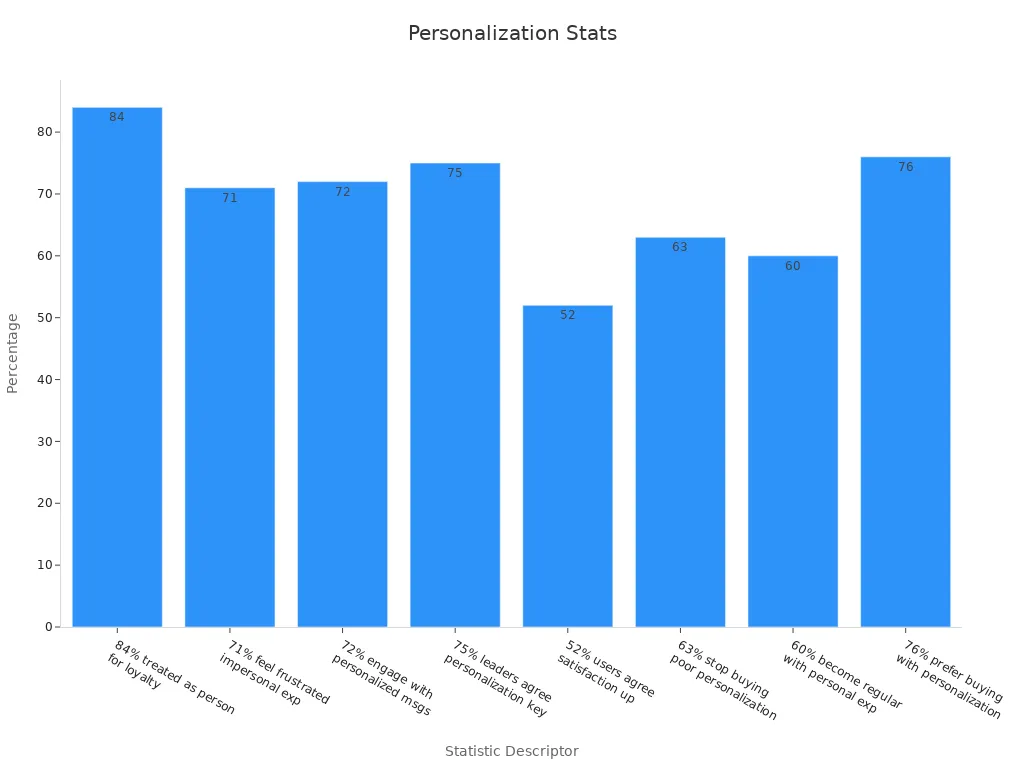Actionable Tips to Personalize Customer Experiences

Have you ever wondered how to connect with a customer on a deeper level? Personalization holds the key. When you tailor your interactions to meet individual needs, it creates a meaningful experience that customers value. In fact, 91% of consumers are more likely to shop with brands offering relevant recommendations, and 80% say they’re more likely to stay loyal to businesses that personalize their approach.
The benefits don’t stop there. Companies using personalized strategies often see double-digit revenue growth and higher customer engagement. Proactive, personalized service can also boost retention rates by up to 20%. With tools like Sobot, businesses can create these impactful experiences effortlessly.
Why Personalization Matters in Customer Experience
The Role of Personalization in Customer Satisfaction
Personalization transforms ordinary customer interactions into positive customer interactions that leave a lasting impression. When you understand customer needs and tailor your approach, you create an experience that feels unique and valued. For example, 71% of buyers want companies to deliver personalized customer interactions, and 64% of marketers agree that customer satisfaction is the top benefit of personalization.
Think about how to connect with a customer on a deeper level. It’s not just about addressing them by name; it’s about anticipating their preferences and offering solutions that resonate. Companies that excel in personalized customer experience often see higher satisfaction rates. In fact, 77% of consumers are more likely to choose or recommend brands that offer personalized experiences.
By focusing on personalization, you can turn every interaction into an opportunity to build trust and loyalty, ensuring your customers feel heard and appreciated.
How Personalization Drives Customer Loyalty
Personalized interactions are the cornerstone of customer loyalty. When you show customers that you truly understand them, they’re more likely to stick around. Imagine a financial institution sending targeted messages about relevant loan options based on precise customer data. This kind of engagement fosters trust and strengthens long-term relationships.
Tailored strategies also make customers feel valued. Companies that demonstrate knowledge of their customers through personalized communications are perceived as more trustworthy. This perception directly impacts customer retention, as loyal customers are more likely to return and recommend your brand to others.
Personalization isn’t just a strategy—it’s a way to create genuine connections that keep customers coming back.
Competitive Edge Through Personalized Interactions
In today’s crowded marketplace, personalized interactions give you a competitive edge. Understanding customer needs allows you to deliver timely and appealing experiences that stand out. For instance, personalized engagement can increase average revenue per user by 166%, showcasing its financial impact.
Customized strategies like targeted ads and tailored recommendations ensure effective communication with customers. Netflix, for example, drives 80% of its content consumption through personalized recommendations, achieving a 93% user satisfaction rate.
By leveraging personalization, you not only enhance customer engagement but also position your brand as a leader in delivering exceptional customer experiences.
Leveraging Data to Enhance Customer Interaction Strategy
Collecting and Organizing Customer Data
Data is the foundation of any successful customer interaction strategy. To create personalized experiences, you need to start by collecting and organizing customer data effectively. But how do you do that? By using robust methods that capture meaningful insights about your customers.
Here’s a quick look at some of the most effective data collection methods:
| Data Collection Method | Description |
|---|---|
| Surveys | Gather qualitative and quantitative data through questionnaires, useful for feedback and improvement. |
| Transactional Tracking | Tracks customer purchases to inform targeted marketing and understand customer behavior. |
| Interviews and Focus Groups | Collects qualitative and quantitative data through direct interaction with subjects. |
| Observation | Provides real-time insights into user interactions with products or websites. |
| Online Tracking | Uses tools like pixels and cookies to gather behavioral data on user engagement across websites. |
Each method has its strengths. For example, surveys can help you understand customer satisfaction, while transactional tracking gives you insights into buying patterns. By combining these methods, you can build a comprehensive view of your customers.
Once you’ve collected the data, organizing it is just as important. Use tools like customer relationship management (CRM) systems to store and categorize information. This ensures that your data is not only accessible but also actionable.
Analyzing Customer Preferences and Behaviors
Collecting data is just the beginning. To truly enhance your customer interaction strategy, you need to analyze that data. This step helps you uncover patterns and preferences that can guide your personalization efforts.
For instance, a mid-sized fashion retailer saw a significant boost in online purchases after analyzing customer preferences. They revamped their website to improve the user experience and introduced personalized recommendations. Their focus on sustainability even led to the launch of an eco-friendly clothing line, which increased conversion rates and strengthened customer loyalty.
When you analyze customer behaviors, you can identify what works and what doesn’t. Are customers abandoning their carts? Are they engaging more with certain types of content? These insights allow you to make data-driven decisions that improve customer satisfaction and retention.
Using Data to Create Dynamic Customer Profiles
Dynamic customer profiles are the secret sauce of personalization. These profiles go beyond basic demographics to include preferences, behaviors, and even context-based support needs. By leveraging data, you can create profiles that adapt in real-time, ensuring every interaction feels relevant and personalized.
Imagine you’re running an e-commerce store. A dynamic profile might show that a customer prefers eco-friendly products and often shops during sales. With this information, you can send them personalized offers during your next promotion. This not only boosts engagement but also builds customer loyalty.
To create these profiles, start by segmenting your audience. Strategic customer segmentation allows you to group customers based on shared characteristics. Then, use tools like AI and machine learning to update these profiles dynamically. This ensures that your customer interaction strategy remains effective and up-to-date.
Dynamic profiles don’t just enhance personalization—they also enable context-based support. For example, if a customer contacts your support team, their profile can provide agents with all the information they need to offer tailored solutions. This level of service makes customers feel valued and improves their overall experience.
Technology as a Key Enabler for Personalized Customer Service

CRM Systems for Managing Customer Relationships
Customer relationship management systems are the backbone of personalized customer service. These tools help you organize, track, and analyze customer data, making it easier to deliver tailored experiences. Imagine having a system that tells you exactly what your customers want, when they want it, and how they prefer to interact with your brand. That’s the power of CRM.
Studies show that CRM systems significantly improve customer satisfaction and operational efficiency. For example:
| Study Focus | Findings | Implications |
|---|---|---|
| Evaluation of CRM systems in tourism and hospitality | Investigates the relationship between CRM applications and ICT management practices | Provides practical suggestions for CRM evaluation and implementation strategies |
By using CRM systems, you can streamline customer interactions and ensure every touchpoint feels personalized. Tools like Sobot’s Live Chat integrate seamlessly with CRM platforms, allowing you to unify customer data and provide consistent service across channels. This integration not only boosts efficiency but also strengthens customer loyalty by showing customers you truly understand their needs.
AI and Machine Learning for Predictive Personalization
AI and machine learning are game-changers in personalized customer service. These technologies analyze vast amounts of data to predict customer preferences and behaviors. They help you anticipate what your customers need before they even ask.
Here’s how AI enhances personalization:
- AI utilizes customer data to create tailored communication messages.
- Personalized emails, push notifications, and chatbot interactions lead to increased engagement and response rates.
Retailers using AI for predictive personalization often see remarkable results. For instance, a survey by the IBM Institute for Business Value found that organizations focusing on customer experience achieve three times the revenue growth compared to their peers. Additionally, 86% of CEOs identified personalization as a crucial element of their customer experience strategies.
Imagine sending a customer a product recommendation based on their browsing history or offering a discount on an item they’ve been eyeing. These small gestures make a big impact. Sobot’s AI-powered solutions, like its Chatbot and Live Chat, take this a step further by providing real-time, context-based support. This ensures every interaction feels relevant and personalized, boosting customer satisfaction and loyalty.
Sobot Live Chat: Enhancing Customer Engagement Across Channels
If you’re wondering how to connect with a customer across multiple platforms, Sobot Live Chat is the answer. This tool lets you engage with customers on their preferred channels, whether it’s your website, social media, or smartphone app.

Sobot Live Chat doesn’t just unify communication; it transforms customer interactions into meaningful experiences. Its omnichannel support ensures no missed opportunities, while AI-assisted tools help agents deliver personalized service efficiently. For example, the platform’s customer segmentation feature allows you to target specific groups with tailored messages, increasing engagement and conversion rates.
The numbers speak for themselves. Businesses using Sobot Live Chat have reported a 38% gain in conversion rates and extended customer lifecycles. Plus, its built-in analytics evaluate over 150 indicators, helping you make data-driven decisions to improve service quality.
With Sobot Live Chat, you’re not just managing customer interactions—you’re creating experiences that customers remember and appreciate. Whether it’s through timely responses, rich messaging options, or satisfaction surveys, this tool empowers you to deliver personalized customer service that stands out.
Humanizing Customer Interactions for Better Connections
Training Teams to Deliver Personalized Service
Your team plays a crucial role in delivering personalized customer service. When your employees are well-trained, they can better understand customer needs and provide tailored solutions. Training programs focused on human-centered design can transform how your team approaches customer interactions.
Here’s a quick look at the benefits of training your team:
| Benefit of Training Teams in Human-Centered Design | Description |
|---|---|
| Higher success rate of corporate innovation efforts | Focus on products and services that customers want and need. |
| Better collaboration among organizational functions | Aligns teams around a shared customer-led approach. |
| Improved customer experience, engagement, and loyalty | Creates relevant and enjoyable products and services. |
| Increased relevance of offers and reduced time-to-market | Empathetic design leads to more appealing and timely offers. |
| Increased productivity and efficiency | Focuses on critical issues, reducing trial-and-error. |
| True organizational empowerment | Encourages re-evaluation of customer problems and solutions. |
Companies like Samsung and Midco have seen remarkable results by training their teams to deliver personalized customer engagement. Samsung once customized a phone for a loyal customer, showcasing how to connect with a customer on a deeper level. Midco tailored solutions to meet customer needs, making them feel valued and supported. These examples highlight the power of training in creating effective customer interactions.
Active Listening and Empathy in Customer Conversations
Active listening and empathy are the cornerstones of personalized customer service. When you truly listen to your customers, you understand their concerns and can offer solutions that resonate. Empathy allows you to step into their shoes and see the world from their perspective.
Imagine a customer reaching out with a complaint. Instead of jumping to conclusions, you listen carefully, acknowledge their feelings, and provide a thoughtful response. This approach not only resolves the issue but also strengthens the relationship. Personalized support like this builds trust and loyalty, ensuring customers feel heard and appreciated.
Empathy also helps you leverage proactive engagement for anticipatory support. By understanding your customers’ needs, you can address potential issues before they arise, creating a seamless experience.
Tailoring Communication Channels to Customer Preferences
Not all customers prefer the same communication channels. Some might like chatting on social media, while others prefer email or phone calls. Tailoring your communication methods to match customer preferences is key to delivering personalized customer engagement.
HP, for instance, offers multiple channels for customer interactions, ensuring personalized assistance across platforms. By meeting customers where they are, you make it easier for them to connect with your brand. Tools like Sobot Live Chat simplify this process by unifying communication channels, allowing you to provide consistent and personalized customer service.
When you tailor your communication channels, you create a more enjoyable experience for your customers. They’ll appreciate the effort you put into making their interactions convenient and meaningful.
Personalization Strategies Across Customer Touchpoints

Customizing the Onboarding Process
The onboarding process is your first chance to make a lasting impression. A personalized approach here can set the tone for a strong relationship. When you tailor onboarding to individual needs, customers feel valued and understood. For instance, offering step-by-step guides based on user preferences or providing interactive tutorials can make the experience more engaging.
Statistics back this up. According to Salesforce, 65% of consumers expect personalized experiences, and 72% report increased loyalty when service delivery is faster. Additionally, 73% say valuing their time with self-service options is crucial for quality. These numbers highlight how a customized onboarding process can boost customer satisfaction and loyalty.

By focusing on personalization during onboarding, you create targeted experiences that resonate with your audience. This not only improves customer experience but also sets the stage for long-term engagement.
Personalizing Marketing Campaigns and Offers
Personalized marketing communications are a game-changer. They allow you to connect with customers on a deeper level by offering solutions that match their preferences. Starbucks is a great example of this. The company uses its mobile app to collect data on customer purchases and preferences. With this information, they create targeted campaigns, such as offering discounts on frequently purchased items.
Here’s how Starbucks achieved success with personalized marketing:
- Their gamified rewards system, integrated into the app, uses purchase history and location data for tailored offers.
- This strategy led to a revenue increase to $2.56 billion.
- The app now generates around 6 million sales per month, accounting for 22% of all U.S. sales.
By leveraging data-driven insights, you can craft campaigns that feel relevant and timely. This approach not only drives sales but also strengthens customer loyalty.
Delivering Tailored Recommendations and Solutions
Tailored recommendations are the cornerstone of a great customer experience. When you use data to understand customer preferences, you can offer solutions that truly meet their needs. For example, an e-commerce store might suggest eco-friendly products to a customer who values sustainability. This level of personalization makes interactions more meaningful.
Dynamic customer profiles play a key role here. These profiles adapt in real-time, ensuring every interaction feels relevant. Tools like Sobot Live Chat make this process seamless by integrating customer data and providing agents with actionable insights. This allows you to deliver personalized solutions quickly and efficiently.
When you focus on delivering tailored recommendations, you show customers that you understand them. This builds trust and keeps them coming back for more.
Personalization isn’t just a buzzword—it’s the foundation of meaningful customer interactions. When you tailor your approach, you create an experience that resonates, builds trust, and fosters loyalty. The numbers speak for themselves: 84% of customers say being treated like a person is crucial for loyalty, and 76% prefer to buy from companies that offer personalization.
| Statistic | Source |
|---|---|
| 84% of customers say being treated like a person is crucial for loyalty. | Salesforce |
| 71% of customers feel frustrated with impersonal experiences. | Segment 2017 Personalization Report |
| 72% of customers engage only with personalized messages. | Wunderkind |
Throughout this blog, we’ve explored actionable strategies to enhance customer engagement. From leveraging data to creating dynamic profiles, to using tools like Sobot Live Chat for omnichannel support, every step brings you closer to delivering exceptional experiences.

Now it’s your turn. Start small—analyze your customer data, train your team, or personalize your onboarding process. Each effort adds up, transforming your customer interactions into moments that matter. The journey to better customer experiences begins today.
FAQ
What is the best way to start personalizing customer interactions?
Start by collecting and organizing customer data. Use tools like CRM systems to store and analyze this information. This helps you understand customer preferences and tailor your approach to meet their needs effectively.
How can technology improve customer engagement?
Technology like AI and live chat tools enhances engagement by providing real-time, personalized support. For example, Sobot Live Chat allows you to interact with customers across multiple platforms, ensuring seamless and meaningful experiences.
Why is active listening important in customer interactions?
Active listening helps you understand customer concerns and respond thoughtfully. It builds trust and shows customers that you value their input, creating stronger connections and improving overall satisfaction.
How does Sobot Live Chat support personalized service?
Sobot Live Chat unifies communication channels and uses AI-powered tools to deliver tailored solutions. Its features, like customer segmentation and built-in analytics, help you provide efficient and personalized support.
What are dynamic customer profiles, and why are they useful?
Dynamic customer profiles adapt in real-time based on customer behavior and preferences. They allow you to offer relevant recommendations and solutions, making every interaction more meaningful and effective.
See Also
10 Strategies to Enhance Customer Satisfaction in Live Chat
10 Guidelines for Selecting Social Media Support Tools
10 Actions to Deploy Omnichannel Contact Center Strategies
AI-Driven Customer Service Agents Transform Support Experience
